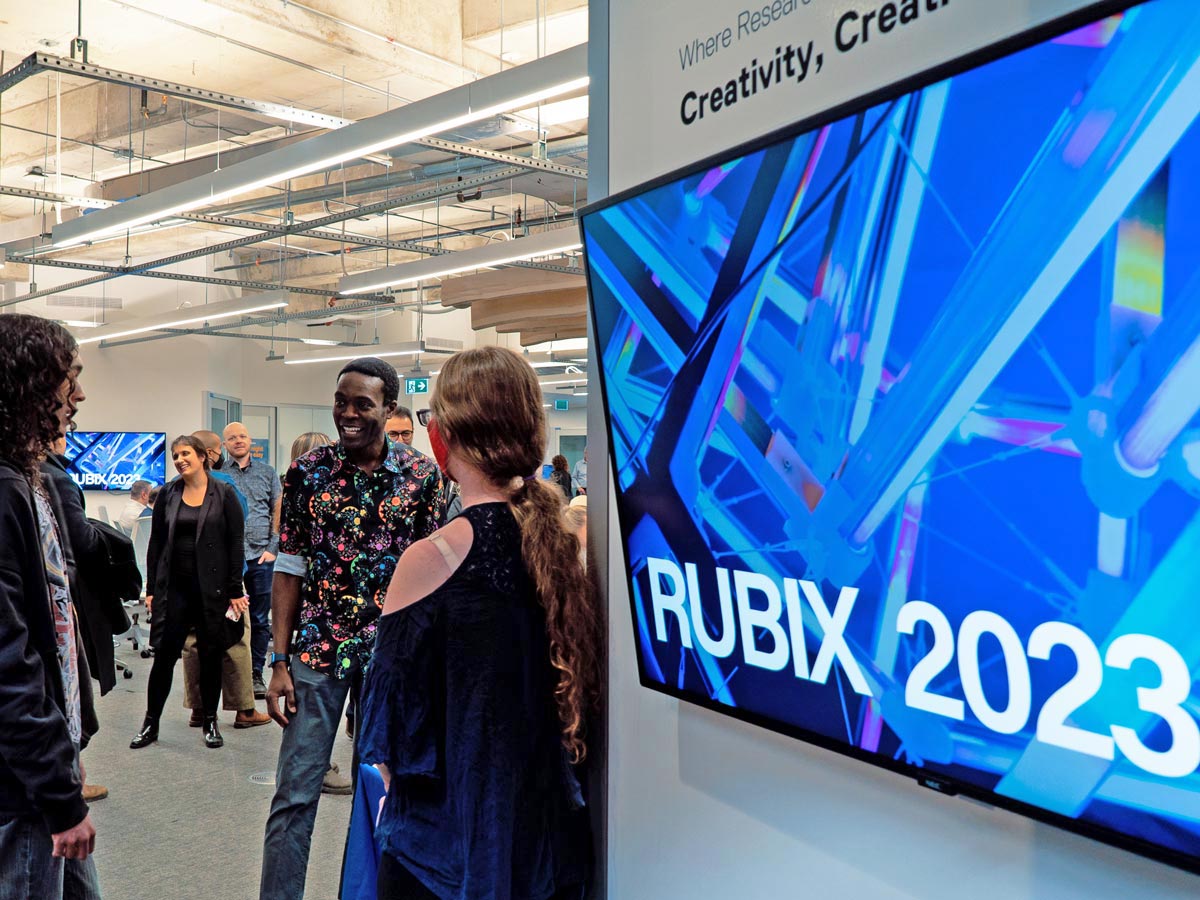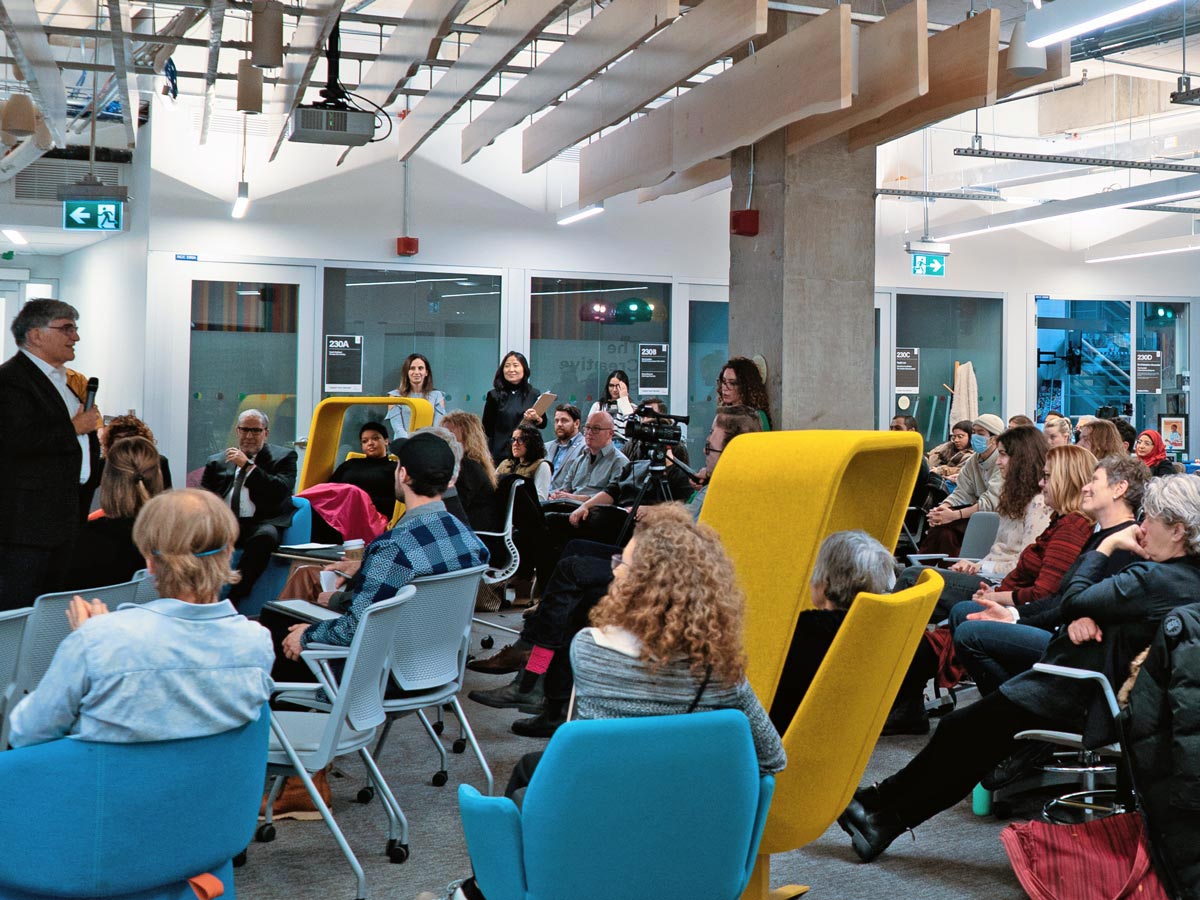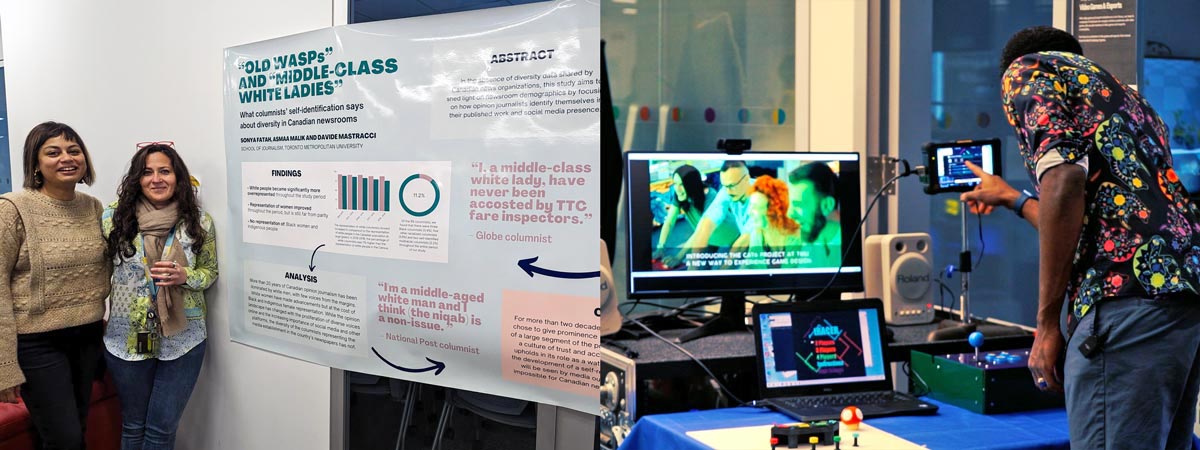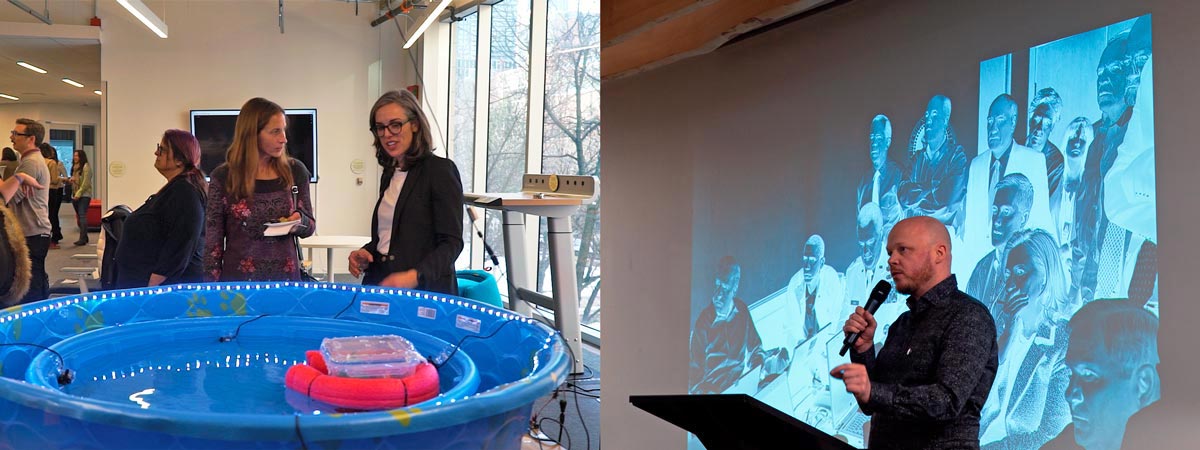Event recap: RUBIX 2023 features creative, transformational and disruptive research

RUBIX 2023 showcased innovative creative research through installations and presentations on January 26, 2023. Photo: Qais Pasha
From water-performing drones to explorations of vulnerability to sustainable packaging, the RUBIX 2023 event showcased projects from The Creative School's faculty and students featuring a diverse array of scholarly, research and creative activity on January 26, 2023.
The annual RUBIX event returned to an in-person, live format for the first time since 2019 at The Catalyst. Attendees had the opportunity to explore projects and demonstrations, and to listen to researchers give rapid and focused presentations through a PechaKucha (Japanese for “chit chat”) Social format.
As part of the welcoming remarks from university officials, Steven N. Liss, TMU’s vice-president, research and innovation, challenged attendees to consider reaching across disciplinary boundaries and faculties to collaborate. “The Catalyst at The Creative School exemplifies the innovative and diverse activities taking place here, and through the dynamic research, experimentation and collaboration, we’re driving innovation,” he said. “The variety of talented and innovative projects you will see here today showcase accomplishments that are critical to our research excellence and the global reach of TMU.”

The Creative School Dean Charles Falzon offers introductory remarks at the start of RUBIX 2023. Photo: Qais Pasha
Project and presentation examples
After a keynote speech by University of Alberta contemporary art and theory professor Natalie Loveless about research-creation, attendees had the chance to explore an “installation walkabout” featuring 13 projects and a display of 24 books published by faculty since 2015, providing an overview of the wide-range of work being done at The Creative School.
One of those projects offered attendees the opportunity to interact with a “hydrone” prototype, a small floating drone set up in a small pool of water fitted with a camera and sensors.
Research scientist Alexander Bakogeorge drew a parallel to drone air shows, noting, “The idea is to do something similar in the water.” He said having hydrones perform in public bodies of water, like fountains, would make such drone shows more accessible to the public.
Journalism professors Asmaa Malik and Sonya Fatah tackled the lack of diversity in the opinion pages of major Canadian newspapers, such as The Globe and Mail, The National Post and the Toronto Star, with their projects “Old WASPs” and “Middle-class White Ladies.”
“Newsrooms are so reluctant to give that [demographic] data out,” said professor Fatah, but many of the 89 columnists they reviewed self-identify their race and economic status. During the 20 years studied, from 1998-2018, they found white people became over-represented compared to Canada’s population. In addition, while the representation of women improved, there was an absence of Black women and Indigenous people in the news and political commentary columns.
At the Community Arcade Table 6 demonstration table, attendees could use a multi-player arcade style cabinet to try out a game programmed by a TMU student, offer feedback and have fun together. Student Maeve Fitzgerald leads the project, supervised by professor Kristopher Alexander. She demonstrated her game Tracer, described as a combination of Pac-Man, Tron and Asteroids that allowed players to choose to work together or compete. She said through her experiences with classes at TMU she went from knowing no Python, a programming language, to being able to create a game in just a couple of months.

Left: Journalism professors Asmaa Malik (left) and Sonya Fatah (right) with their exhibit on Canadian opinion columnists and diversity. Right: Professor Kristopher Alexander with his project, the Community Arcade Table 6. Right photo: Qais Pasha
PechaKucha Social
Through three rounds of the PechaKucha Social, researchers used 20 slides shown for 20 seconds each to present projects dynamically and compellingly. Hosted by Creative Industries professor David Gauntlett, the Canada Research Chair in Creative Innovation & Leadership and Ashley Lewis, the manager and co-director of The Creative School’s Innovation Studio, 15 faculty members offered rapid insights into their projects.
“In what ways can language kill?” asked School of Performance professor Matt Jones, presenting his project Necro-Performance and the Global War on Terror. With the idea of “necro-performance,” he explored different aspects of words causing death, such as an execution order.
Professor Jones also considered the less obvious ways words can hurt. For example, policies that deprive some people of their rights can signal to society that that group can be harmed or mean the difference between being treated as a prisoner of war, with protection from the Geneva Conventions, or an enemy combatant who is tortured. Finally, he considered how necro-performance could be an act of resistance, memorialization and even art.

Left: RUBIX attendees examine the hydrone project, which is a water-based drone prototype. Right: professor Matt Jones gives his PechaKucha presentation on necro-performance. Photos: Qais Pasha
Image Arts professor Michèle Pearson Clarke spoke about exploring feelings of fear and grief and contemporary queer female masculinity in her project Quantum Choir (external link, opens in new window) .
“My work has always asked for a great deal of vulnerability from my participants and it’s become clear that sometimes I ask for too much and the projects fall apart,” said professor Clarke. “In trying to unpack these moments of creative failure, I wanted to look at the idea of “too much.”
Professor Clarke and three participants overcome their anxiety and shame around being bad singers in order to learn and perform the song "Queen of Denmark" by queer artist John Grant. Each participant was filmed individually, with the videos edited together to create one 12-minute and 46-second performance displayed on four separate screens.
At the intersection of engineering and design lies Graphic Communication Management professor Ehsan Behzadfar’s presentation, Beauty and Challenges of Bio-based Biodegradable Polymers for Sustainable Packaging. Professor Behzadfar explained how his team takes a holistic approach to developing bioplastics for packaging by looking at the materials, the processes used to create them and the final materials’ properties. “If we change the material, how will the properties be affected?” said professor Behzadfar.
To learn more about all the projects presented as part of the event visit the RUBIX 2023 webpage.
Related links
RUBIX 2023 brings together thought leaders from across the creative fields to explore and innovate